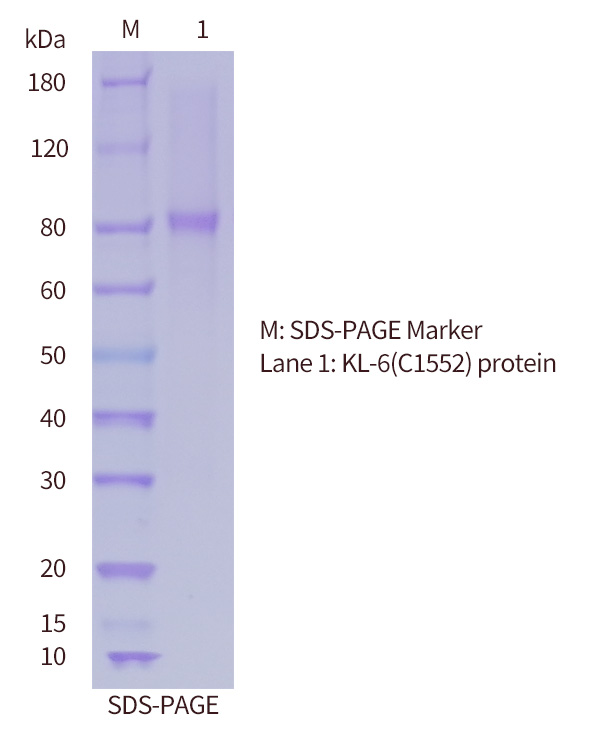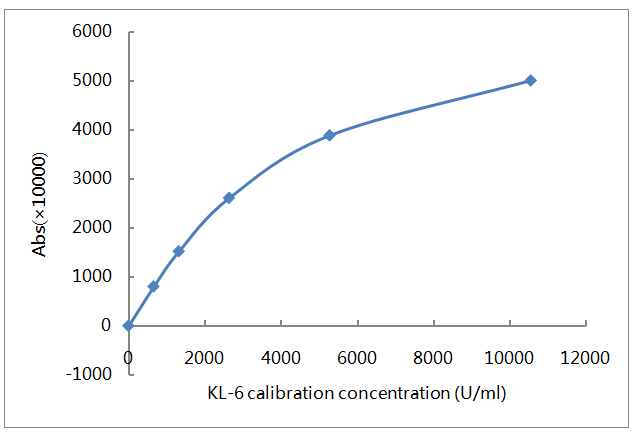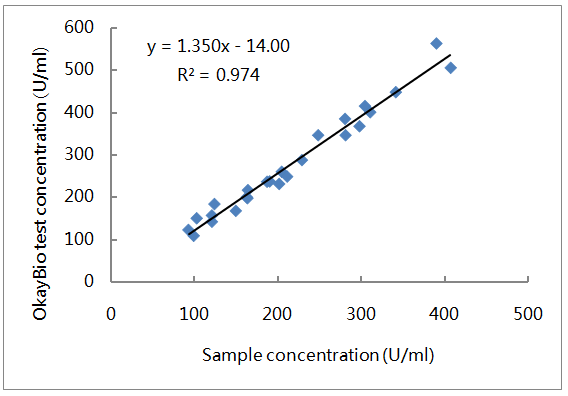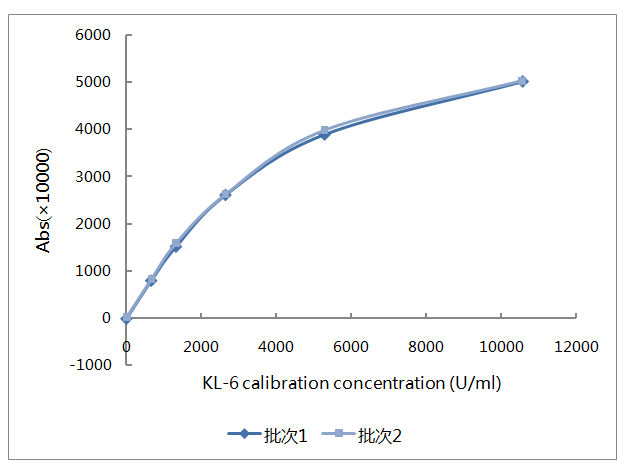Krebs Von den Lungen-6 (KL-6)

KL-6 Antibody
| Name |
Anti-Human Krebs Von den Lungen-6 (KL-6) antibody |
| Platforms |
Chemiluminescence immunoassay (CLIA), Turbidimetric Immunoassay (TIA) |
| Catalog # |
K72c8 |
K73d9 |
| Usage |
Capture/Detection |
Capture/Detection |
| Source |
Mouse monoclonal antibody, cultured in vitro |
| Buffer |
1xPBS,pH 7.4 |
| Purity |
Purity>96%, purified by Protein A/G chromatography |
| Storage |
Aliquot and store at -20°C or lower. Avoid freeze / thaw cycles. |

KL-6 Antigen
| Name |
Krebs Von den Lungen-6 (KL-6) antigen |
| Description |
Recombinant, C-terminal Fc-tagged, in vitro expressed from mammalian cells |
| Applications |
Calibrator and quality control product |
| Catalog # |
C1552 |
| Purity |
>90%, analyzed by R250-stained SDS-PAGE |
| Buffer |
1xPBS,pH 7.4 |
| Storage |
Aliquot and store at -80°C. Avoid freeze / thaw cycles. |
| SDS-PAGE |
Predicted MW around 59kDa (tagged)

|

Product Information
Latex Turbidimetric Immunoassay (LTIA) platform
Calibration curve
K72c8-K73d9 matched antibody pair was conjugated with latex microspheres to prepare R2 reagent. R1 buffer solution was mixed with R2 to prepare latex turbidimetric immunoassay (LTIA) test kit. HitachiTM 7080 automatic biochemical analyzer was used to quantitatively detect the Krebs Von den Lungen-6 (KL-6) calibrator as Fig.1.

Fig.1 Calibration curve
Clinical comparative analysis
Krebs Von den Lungen-6 (KL-6) latex turbidimetric immunoassay (LTIA) test kit was verified in Japan supplied random assigned samples (25 cases), clinical coefficient of determination R²=0.974。

Fig.2 Correlation of KL-6 in clinical sample
Intra batch repeatability
Same batch of reagent kits were prepared with K72c8-K73d9 matched antibody pair to measure the concentrations of three quality control samples, with each group repeated 10 times, and the concentrations of volume (CV) were 5.26%, 1.80%, and 0.83%, respectively.
| Sample |
Test 1 |
Test 2 |
Test 3 |
Concentration
(U/mL)
|
615 |
1542 |
3287 |
| 530 |
1559 |
3336 |
| 556 |
1541 |
3262 |
| 540 |
1550 |
3350 |
| 543 |
1590 |
3324 |
| 521 |
1570 |
3327 |
| 556 |
1631 |
3326 |
| 526 |
1584 |
3326 |
| 533 |
1572 |
3346 |
| 515 |
1543 |
3340 |
| AVE |
543.5 |
1568.2 |
3322.4 |
| SD |
28.5861 |
28.2127 |
27.4153 |
| CV |
5.26% |
1.80% |
0.83% |
Inter batch repeatability
Two batches of reagents were prepared using K72c8-K73d9 matched antibody pair, and six quality control samples with different concentrations were tested separately.

Fig.3 Inter batch repeatability
Heat stability
K72c8-K73d9 matched antibody pair was stored at 37℃ for 0, 3, 4, 5, 12 days, and the absorbance values of six of quality control samples with certain concentrations were measured respectively .

Fig.4 Heat stability

Sign up for a free trial

Diagnostic Significance of Krebs Von den Lungen-6 (KL-6)
Krebs Von den Lungen-6 (KL-6) is a transmembrane mucoprotein with high molecular weight, which contains a sialylated sugar chain with a molecular weight of about 200 kDa. The sugar chain is mainly composed of a tandem repeat sequence with 20 amino acid residues, and has a spatial epitope structure able to be recognized by specific antibodies. KL-6 is mainly expressed in the cytoplasm and membrane of type II alveolar cells and bronchial epithelial cells, and is partially expressed in the bronchiolar basal cells, cytoplasm of Clara cells. It can serve as a specific indicator for lung tissue diseases.
According to relevant research reports, the mechanisms by which KL-6 participates in pulmonary lesions mainly include the following:
① KL-6 normally expressed in the body, has a protective effect on lung tissue. Its glycosylated side chain provides a hydrophilic environment for maintaining lubrication of the bronchial epithelium, and forms brush like structure with peptides as the core and glycosylated side chains as branches to clear foreign matters and pathogenic bacteria in the lung, and to prevent damage to lung tissue by some harmful degrading enzymes.
② Participate in immune response. KL-6 antibody induced mucoprotein 1 can repair proteins of cell surface and improve cytotoxicity of killer cells, thus increase the chemotaxis of effector cells to kill tumor cells.
③ KL-6 can promote the proliferation and migration of fibroblasts, inhibit cell apoptosis, and aggravate the development of pulmonary fibrosis.
Differential diagnosis of interstitial pneumonia and other related diseases
Relevant studies indicate that the high expression of KL-6 may be related to interstitial lung disease (ILD), acute lung lesions, radiation pneumonia, viral pneumonia, drug-related interstitial pneumonia, tumors and other diseases. In the research of Ren et al., by comparing the serum levels of KL-6 in patients with ILD, other lung diseases and healthy people, they found that the concentration of KL-6 in patients with ILD was significantly higher (about 6-10 times) than that in patients with chronic obstructive pulmonary diseases, pneumonia, tuberculosis, bronchiectasis and other diseases and healthy people. Therefore, the detection of KL-6 can be used to distinguish interstitial lung diseases from other pulmonary diseases.
Prognosis after treatment for interstitial pneumonia
For patients with interstitial pneumonia, after taken relevant therapeutic drugs, the concentraton of KL-6 will decrease to varying levels in those who improved their conditions. If the condition is stable, there is usually no significant change in the level of KL-6. As the condition worsens, the KL-6 will increase to varying levels. Therefore, detection of KL-6 concentration helps to monitor the therapeutic effect for interstitial pneumonia.
Evaluation to the risk of drug-related interstitial pneumonia
The main side effect of anticarcinogenic drug PD-1/PD-L1 inhibitors is the causing of interstitial pneumonia. Before and during medication process, dynamic monitoring of KL-6 is necessary to control medication risks and reduce the possibility of causing drug-related interstitial pneumonia.

Related Products




